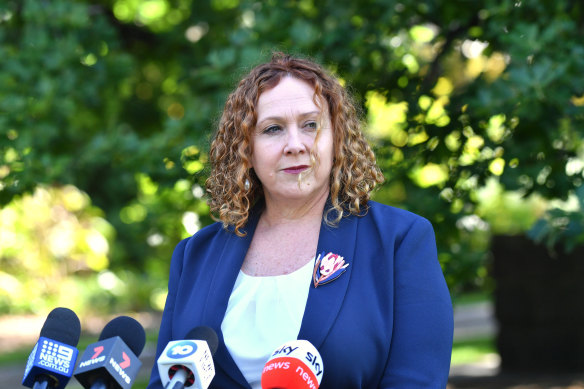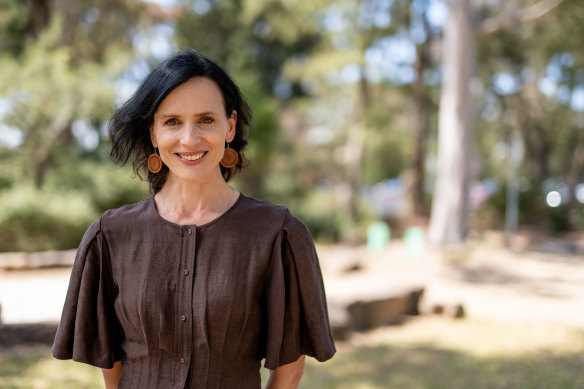By Najma Sambul
Home owners have been buoyed by Victoria restricting council rate rises to 2.75 per cent for the 2024-25 financial year, but local governments have warned they will be forced to choose which essential services and infrastructure will suffer.
The Allan government on Friday said the cap was based on the forecast consumer price index – which measures inflation – for the period, aiming to reduce pressures on household budgets as the cost-of-living crisis squeezes Victorians.

Local Government Minister Melissa Horne has announced a rate cap decrease in the next financial year for households as cost-of-living pressures hit Victorians.Credit: Joe Armao
But local government bodies and councils have slammed the “extreme” call, saying actual inflation had easily surpassed the cap for the past three years, and they were struggling to keep up.
Municipal Association of Victoria president David Clark said tough decisions were going to be made as the cap reduced a key revenue source for councils.
“Councils are dealing with spiralling costs on multiple fronts,” said Clark, who is also a councillor at Pyrenees Shire Council in western Victoria. “To decrease the rate cap at this time means many councils will be struggling to deliver the services and infrastructure our communities rightly demand.
“While local government goes backwards by 30 per cent compared to CPI since the introduction of the rate cap, all while the state and federal budgets increase far beyond this. For councils to be stuck at 2.75 per cent is going to be challenging in the extreme.”

Mayor of Knox City Council Jude Dwight slammed the state government’s rate cap decrease.
Jude Dwight, Mayor of Knox City Council, which covers Melbourne suburbs including Boronia, Wantirna and Ferntree Gully, said construction and fuel costs were moving at a considerably higher rate than the CPI.
“Over the past three years, the rate cap has increased 6.75 per cent cumulatively, whereas CPI has increased 15.15 per cent,” she said. Dwight accused the state government of “double standards” on revenue raising.
“The state government talks a good game about limiting costs of living pressures by restricting council rate increases to 2.75 per cent,” she said. “But by comparison, their budget papers released only two weeks ago show that their own tax take will increase by 5.8 per cent next year, and has increased 46.1 per cent over the past three years.”
On Friday, the state government also announced a hike in public transport fees from January 1 – up 6 per cent in line with inflation – to “ensure that we are covering the cost of delivering the services Victorians tell us that they need”.
Daily full-fare tickets will rise by 60¢ to $10.60 for travel anywhere across Victoria, with concession fares rising by 30¢ to $5.30. It was the second fare increase in six months, following a surprise June hike that bumped a full-fare daily pass up by 80¢ to $10.
The state government’s decision to cap council rates was made under its Fair Go Rates system, introduced in 2016 to ease the cost of living. Before its introduction, council rates increased by an average of 6 per cent per annum. Since then, the average rate rise between the 2016-17 and 2023-24 financial years was 2.25 per cent.
Local Government Melissa Horne said it provided certainty for home owners. “The rates cap has made a real difference to household budgets over the past eight years and we’ll keep working to reduce costs for families,” she said.
City of Boroondara Mayor Lisa Hollingsworth said the announcement showed the state government was not committed to working with councils.
“The Victorian government’s strategically timed announcement on the day of Christmas closure for most businesses is disappointing and does not illustrate a minister committed to work in partnership with local governments,” Hollingsworth said.
“While we remain committed to sound management and fiscal responsibility, we cannot continue to accommodate such irresponsible rate capping without it impacting services. In the end, the community will be the loser.”
Clark, from the Municipal Association of Victoria, said the state’s cap system needed to be reviewed.
“The rate cap is a blunt instrument that provides no capacity to deal with the diverse needs of individual communities and the councils who service them ... it defies logic to use a catch-all cap for setting rates given the broad variety of challenges,” he said.
But Council Watch president Dean Hurlston said his ratepayers group – a frequent critic of local government – thought the state government had got the rate cap right.
“The notion that councils will need to cut services is absolute bollocks,” he said. “What councils will need to do is live within their means. Their largest cost is staff – keep a lid on it.”
Councils can apply to raise rates above the 2.75 per cent cap, but need to demonstrate community support and why there is a critical need for additional funding. In the 2023-24 financial year, there were no applications for an exemption.
-With Lachlan Abbott
Get the day’s breaking news, entertainment ideas and a long read to enjoy. Sign up to receive our Evening Edition newsletter.